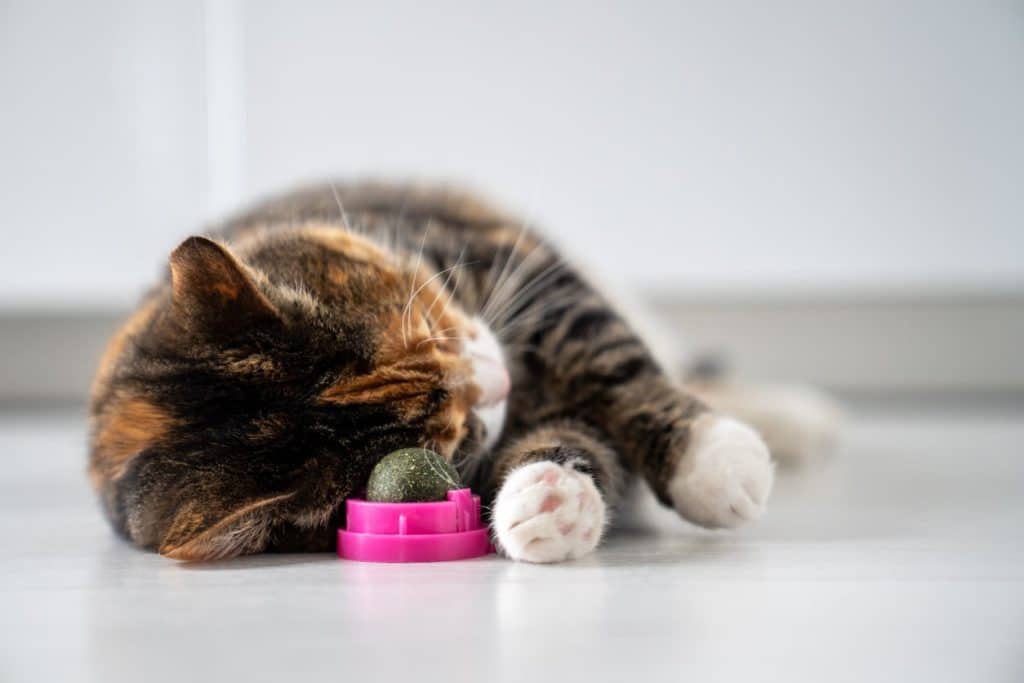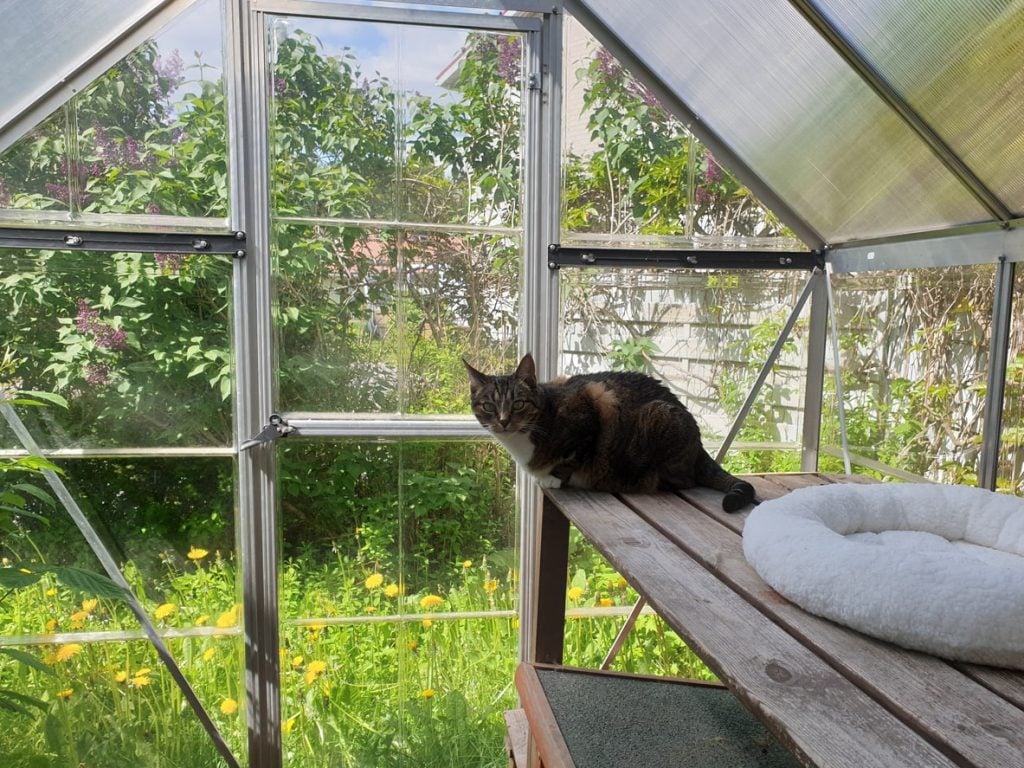- Not a substitute for professional veterinary help.
Have you ever felt like the victim of one too many “drive-by ankle-biting” attacks from your frenzied feline? Or maybe you’re concerned that your couch potato kitty’s cute chunkiness might harm their health? Getting your cat to exercise is important for their overall health and allows them to act on their instincts.
“For cats, play is predatory behavior. Cats who don’t get to hunt and problem solve can become bored and may act out,” says Stephen Quandt, CFTBS and founder of Feline Behavior Associates. Instead, Quandt says cat exercises may help them calm down and be less prone to boredom, destructive behaviors, or over-vocalization.
When cats have opportunities to expend energy, especially through interactive play with their human caregivers, Albert Colominas, Cat Trainer and Behaviorist and Owner at Outdoor Bengal, says benefits go far beyond improving the bond. Mentally and physically engaged cats, Colominas and Quandt say, have a higher quality of life, are healthier, are less likely to engage in destructive and unwanted behaviors, and are often more relaxed.
From structured playtime and interactive toys to incorporating the outdoors and replicating natural hunting behaviors, read on as we explore twelve ways to ensure your cat gets the exercise they need — no matter their age or energy level.
1. Invest in a Cat Tower (or Two)
Nothing beats a classic cat tower if you can only pick one way to exercise your cat! Timeless but never basic, the original kitty playground is often equipped with multiple carpeted tiers for climbing and jumping, built-in scratching posts, dangling toys on bungee strings, and nooks for ambush play.
Cat towers are an all-in-one choose-your-own-adventure for kitties of all energy levels. Besides giving your kitty ample opportunities to engage in instinctive behaviors like climbing and scratching, cat towers are easy to “combine” with toys.
“When we add an interactive toy to the equation, like a wand with a bunch of feathers and a bell, cats have everything they need to drain their energy,” Colominas says.
2. Purchase a Plethora of Cat Toys
When finding the most irresistible toys for our feline friends, the more interactive, the better. “Cats are programmed to respond to motion,” Quandt says.
One of our favorites at Rover is the Potaroma Flopping Fish toy for hours of irresistible fun.

iStock/Vera Aksionava
3. Play With a Laser Toy
If you want to change up your interactive play with your cat and take a break from prey-like motion-activated toys, consider taking a laser pen or pointer for a spin and letting your kitty chase colorful dots around the house.
This type of play comes with some ifs and buts, though! Because your cat can’t physically catch and “kill” the dot, they can become overstimulated and agitated.
“A way to prevent frustration is to hide treats in various locations and then use the laser [toy] to guide your cat to the snack,” Quandt says.
4. Create a Tasty Scavenger Hunt
Colominas says for depressed or bored cats, food is a great motivator to get them moving. One activity he loves doing with less active cats is sensorial exploration– specifically, a scavenger hunt that leads to tasty cat treats.
Colominas suggests hiding treats around the house for this type of play and exercise. This activates your cat’s curiosity and instincts and encourages them to walk around and sniff out where their food is, similar to what they’d do in the wild.
5. Use a Cat Wand
The magic of wand toys is how they hack your kitty’s hunter brain and killer instincts! This interactive exercise requires you and your feline friend to play along, making it one of the most bond-boosting activities you can do.
Whether your cat prefers a spray of feathers, curly ribbons with jingle bells, or tiny plushy prey like birds, mice, or fish, there’s a wand toy for every purrsonality.
If a riveting round of chasing the wand toy becomes your cat companion’s go-to exercise, make sure you keep this one crucial tip in mind:
“Don’t frustrate your cat by not letting them get a ‘kill bite,’” Quandt says, “They need to sink their teeth into that toy at regular intervals, so they get the satisfaction of ‘killing’ [their prey].”

iStock/SolStock
6. Start a Kitty Wheel or Treadmill Routine
Racing rodents, step aside! Felines are ready to take a spin on this exercise equipment. These feline fitness gadgets have evolved far beyond humble hamster wheel models (some are even built into cat towers and scratchers!) and provide an excellent outlet for the most energetic zoomies-prone kitties.
For apprehensive kitties, Colominas suggests taking a positive association approach. “Starting slow and on a positive note is key. We can encourage the cat to use the wheel by luring them with treats, a feather toy, or a laser pointer.”
Once they get the hang of it, don’t be surprised if you see (or hear!) them sprinting their little hearts out whenever an urge for the zoomies hits!
7. Take Your Cat on a Walk
“Many indoor cats might show signs of restlessness or ‘zoomies’ because they’re not mentally or physically engaged,” Colominas says. Leash and harness-training your feline friend for a stroll around the block or taking them to the park combines safety with full sensory stimulation.
Walking your cat on a leash and harness gives them opportunities to engage with nature and expend energy at a pace that feels good to them, making this an exercise option for cats of all ages and activity levels.
8. Set Up a Cat Agility Course
“While agility is mostly regarded for dogs, cats can do everything dogs do and more,” Colominas says. He adds that when cats navigate through tunnels or hoops, they’re exercising their problem-solving skills in addition to their bodies.
The most active and energetic cats will gravitate towards this type of play and exercise. Before setting up a complete agility course, Colominas recommends introducing your cat to each element, starting with the tunnels and boxes before you get to the more complex ones. Positive reinforcement, especially pairing treats with clicker training, can help your cat become more confident with agility course equipment.

iStock/Dima Berlin
9. Use Catnip as a Pre-Workout
Want to instantly boost your kitty’s mood and jumpstart their interactive play? Consider kicking off their play session with a few shakes of euphoria-inducing and pheromone-mimicking catnip. Incorporating catnip into cat exercise can offer physical and behavioral benefits.
Dr. Angelica Dimock, DVM and Managing Shelter Veterinarian with the Animal Humane Society, says catnip acts as a stimulus for many cats and triggers their reward system; as a result, they become more active or playful.
Combine catnip with interactive toys to keep your feline friend fit and mentally engaged.
10. Get Your Cat… Another Cat
Is getting your cat a feline friend a way to boost their fitness? Maybe! “In some homes, especially those with active cats, they may get more exercise because they’re playing with each other, stalking, and chasing,” Quandt says.
If you do decide to welcome a new cat or kitten into your home, don’t expect them to entertain each other (at least right away). Human-led, cat-centered interactive structured play is still essential, even in multi-cat households!
11. Buy Your Cat a Puzzle Feeder
Puzzle feeders are a simple but surprisingly effective way to get less-active cats moving and an opportunity for hyperactive cats to burn off energy.
“Instead of vacuuming food down their throats, [your cat] will have to paw and move toys around to get their food out, creating mental stimulation and activity,” Colominas says. Quandt is also a fan and explains that puzzle toys force your cat to think and problem-solving, providing them with mental exercise.

iStock/RS-photography
12. Assemble an Outdoor Enclosure or Catio
If walking isn’t an option for you or your cat, consider investing in a catio or outdoor enclosure. These kitty clubhouses have been a hot topic for some time, and with good reason!
Portable catios and other outdoor enclosures cater to your cat’s instincts and appeal to their exploratory nature. Additionally, they’re a safe way for cats, especially indoor-only kitties, to experience new scents, sights, and sounds. With the dangers of cars, animal attacks, and deadly parasites removed, your cat companion gets all the physical and mental benefits of time out in nature.
General Cat Exercise FAQs
How do I know if my cat is getting enough exercise?
Currently, there are no firmly established exercise guidelines for cats. Dr. Amber Carter, DVM, ABVP board-certified feline practitioner, and Dr. Mikel Delgado, Certified Cat Behavior Consultant, founder of Feline Minds, and Rover’s resident cat expert, recommend a few 5 to 10-minute short exercise and play sessions per day.
How can I make sure my cat is safe during exercise and avoids injury?
“If you are playing with your cat, it can be helpful to make sure that they have carpeted surfaces that aren’t too slippery so they can gain traction while running around,” Dr. Delgado says. “Otherwise, there is a risk of strains.”
Additionally, Dr. Carter says pet parents should discourage their cats from jumping down from high places, like bookshelves or tall cat furniture.
Lastly, feline behaviorists and veterinarians alike say cat parents should be mindful of the toys they leave around the house. Many toys, especially wand toys with feathers and string, can present a choking hazard.
What are the signs of overexertion in cats?
“Most cats will not overexert themselves unless placed in a highly stressed environment,” Dr. Carter says. “Occasionally, we see kittens overexert themselves and start to pant. While this could be normal for a wild and crazy kitten, it should always be discussed with the veterinarian as panting is otherwise not a normal cat behavior.”
Along with respiratory difficulty, Dr. Delgado says to look out for limping or tenderness on any of your cat’s limbs or paws, as it could be a sign of a soft-tissue injury.



